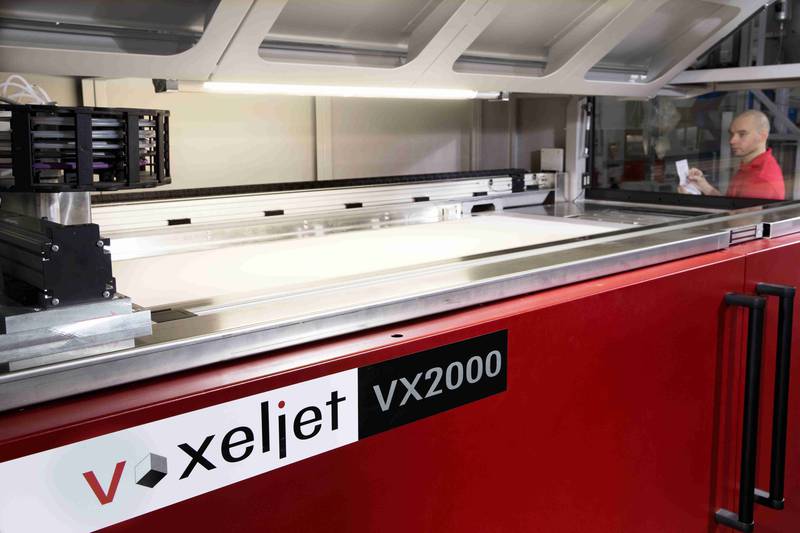German 3D printer manufacturer voxeljet has detailed a new technology development for its High Speed Sintering (HSS) process.
Known as “greyscale 3D printing,” the method allows for the creation of singular parts with variable material properties, from mechanical strength and elasticity to material density, weight and center of gravity. These properties can be individually influenced in different areas of the 3D printed part, without being visible in the component.

High Speed Sintering 3D printing technology
HSS 3D printing is an inkjet-based technology invented and patented by Neil Hopkinson at the University of Loughborough in the early 2000s.
The process involves applying a thin layer of plastic powder to a heated building platform. An inkjet print head moves across the platform and jets an infrared light-absorbing ink in selected areas of the build. The construction platform is then exposed to an infra-red light, allowing the printed areas of the plastic powder to absorb the heat. This, in turn, causes the powder to sinter with the underlying layers. Once the sintering stage is complete, the build platform is lowered by one layer, and the process repeats itself until an object is created.
Hopkinson continued to develop the HSS process with Xaar, a UK supplier of inkjet printheads, where he is employed as the Director of Technology. In 2016, voxeljet obtained a license from the University of Loughborough to help commercialize the HSS process too and develop its own 3D printers equipped with the technology. The following year, the company developed the process for its VX200 3D printer.

What is HSS greyscale 3D printing?
voxeljet has been able to integrate what it terms as “three dimensional mechanical properties” into a 3D printed part by altering the greyscale of the HSS process, which refers to the amount of ink printed into the powder. Up to six different grey levels can be printed into the powder material, depending on the material used. The greyscale per volume can be altered by changing the drop size of the infrared-absorbing ink via printhead bitmaps.
With darker grey tones, more thermal energy can be absorbed by the printed material from the infrared lamp. The varying levels of ink input allows for different degrees of hardness in the 3D printed part, enabling diverse material properties within a single component.

As an example application, voxeljet explains that HSS greyscale 3D printing is particularly suited for the footwear industry, potentially enabling the production of tailor-made shoes with performance and comfort-enhancing features.
3D printed midsoles with lattice structures have already been established as an advanced technology with many benefits in the footwear industry. Mainly, they provide a high degree of comfort and stability for different stress zones in the shoe, depending on the wall thickness of the structures. The likes of adidas and New Balance have released entire shoe lines revolving around 3D printing.
With HSS, a lattice structure, or a solid material, can be imbued with variable target properties. Different amounts of infrared absorbing ink can be imprinted on the stressed areas of a shoe sole. Shoe manufacturers can therefore potentially optimize individual sectors of the 3D printed midsole for specific loads in terms of wearing comfort, stability and elasticity.
Subscribe to the 3D Printing Industry newsletter for the latest news in additive manufacturing. You can also stay connected by following us on Twitter and liking us on Facebook.
Looking for a career in additive manufacturing? Visit 3D Printing Jobs for a selection of roles in the industry.
Featured image shows voxeljet greyscale 3D printed part with variable target properties. Photo via voxeljet.

